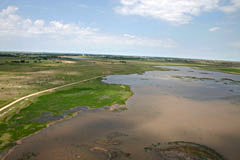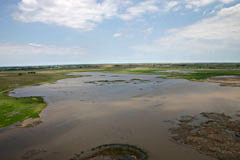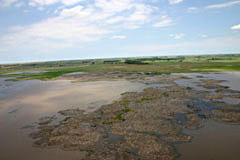

A composite panoramic image can be constructed from a series of overlapping individual frames that are stitched together and projected in cylindrical format. This technique works best if all images are about the same scale, the horizon is roughly level, and each photo displays comparable lighting conditions.
The following example was created using D Joiner software. The four input images were acquired in July, 2004 at Cheyenne Bottoms, a major wetland site in central Kansas. The photos were taken with a Canon Digital Rebel with an 18 mm lens, which produces a wide-angle view equivalent to 28 mm focal length in conventional film format. While quite similar, the four images have slighly different brightness levels owing to different sun positions and cloud shadows for each. These contrast differences are smoothed to be less noticeable in the panoramic composite.
    |
 |
![]() Return to KAP camera rigs.
Return to KAP camera rigs.
![]() More airphotos of Cheyenne Bottoms.
More airphotos of Cheyenne Bottoms.
All text and imagery © by the authors.
Last update Nov. 2004.